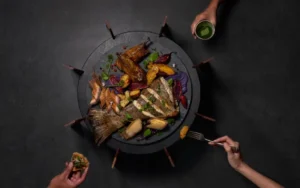How to Host a Matariki Feast
Posted On 2024
How to Host a Matariki Feast: Tips and Ideas
Hosting a Matariki feast is a wonderful way to celebrate the Māori New Year with family and friends. The feast can be a time to honor the traditions of Matariki, share delicious food, and come together in community. Here are some tips and ideas for hosting your own Matariki feast:
- Plan your menu: Food is an important part of any feast, and Matariki is no exception. Plan a menu that includes traditional Māori foods, as well as dishes that incorporate ingredients associated with the season, such as winter vegetables and fruits. Some traditional Māori dishes to consider include:
- Hāngi: a method of cooking food in an underground oven.
- Rewena bread: a sourdough bread made with a fermented potato starter.
- Boil-up: a stew made with meat, potatoes, kumara (sweet potato), and other vegetables.
- Kumara chips: thin slices of kumara that are fried until crispy.
- Puha and pork: a dish made with puha (a type of green vegetable) and pork.
- Seafood: fish and other seafood were important parts of the traditional Māori diet.
- Decorate your space: Creating a festive atmosphere can help set the tone for your Matariki feast. Consider decorating your space with traditional Māori symbols, such as the seven stars of Matariki or the koru (a spiral shape that represents new beginnings). You could also incorporate natural elements, such as flowers, leaves, or branches.
- Set the table: A well-set table can make any feast feel special. Use tablecloths, placemats, and napkins in colors that represent Matariki, such as red, green, and black. Add candles or lanterns for a cozy glow. Consider using dishes and utensils made from natural materials, such as wood or clay.
- Share stories and traditions: Matariki is a time to honor the past and look towards the future. Consider inviting guests to share stories about their own Māori heritage, or to talk about what Matariki means to them. You could also incorporate traditional Māori rituals into your feast, such as karakia (prayers), waiata (songs), or haka (dance).
- Create activities for kids: If you’ll have children attending your feast, consider creating activities that will keep them engaged and help them learn about Matariki. Some ideas include:
- Making Matariki-themed crafts, such as star decorations or koru necklaces.
- Playing traditional Māori games, such as poi (a game where balls attached to strings are swung and caught) or titi torea (a stick game).
- Reading books or telling stories about Matariki and Māori culture.
- Consider a charity component: Matariki is a time to give thanks and think about others in our community. Consider making your feast a charity event by asking guests to bring a donation for a local organization or by donating a portion of the proceeds from the event to a charity of your choice.
- Respect cultural protocols: When hosting a Matariki feast, it’s important to respect cultural protocols and traditions. This may include asking permission to use certain symbols or practices, acknowledging the tangata whenua (people of the land), and following appropriate cultural protocols when cooking or serving food.
Hosting a Matariki Feast
Hosting a Matariki feast is a wonderful way to celebrate the Māori New Year with loved ones. By incorporating traditional Māori foods, decorations, and rituals, you can honor the past and look towards the future with hope and gratitude.


